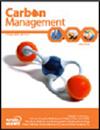2019冠状病毒病疫情期间智利四个城市家庭能源相关温室气体排放趋势
IF 3.2
4区 环境科学与生态学
Q3 ENVIRONMENTAL SCIENCES
引用次数: 6
摘要
摘要2019冠状病毒病(新冠肺炎)大流行严重影响了全球经济和人类生活方式。观察到的国内能源消费模式的变化对家庭温室气体排放产生了影响。由于温室气体排放清单只在国家一级和每年一次提供,大多数研究都通过用较小的时间和地区规模的消费数据外推年排放量来计算当地的排放变化。这项研究提出了一种自下而上的方法,基于对1200户家庭的调查,该方法提供了直接计算其能源相关温室气体排放变化的信息,而无需外推。该方法已应用于智利四个空气质量问题严重的中型城市。鉴于氮氧化物和二氧化碳排放等大气污染物之间的高度相关性,我们估计,在新冠肺炎出现之前,人均二氧化碳排放量已经很高。结果表明,与空间供暖相关的温室气体排放量适度增加(在1%至6%之间),而非供暖用途的电力和天然气消耗排放量显著增加(在8%至23%之间)。这损害了家庭经济,突出了在评估新冠肺炎的整体影响时考虑社会经济方面的重要性。本文章由计算机程序翻译,如有差异,请以英文原文为准。
Trends in household energy-related GHG emissions during COVID-19 in four Chilean cities
Abstract The coronavirus disease 2019 (COVID-19) pandemic has strongly affected economies and human lifestyles globally. The changes observed in domestic energy consumption patterns have had an impact on household greenhouse gas (GHG) emissions. Since GHG emissions inventories are only available at the country level and at annual intervals, most studies have calculated the local emission variations by extrapolating annual emissions with smaller time and territorial scale consumption data. This research presents a bottom-up method, based on the exploitation of a survey addressed to 1200 households, that provides the information to calculate directly the variation in their energy-related GHG emissions, without the need for extrapolations. This method has been applied to four medium-sized Chilean cities with serious air quality problems. Given the high correlation between atmospheric pollutants such as NOx and CO2 emissions, we estimate that before the appearance of COVID-19, per capita CO2 emissions were already high. The results show that space heating-related GHG emissions have increased moderately (between 1 and 6%), while emissions from electricity and gas consumption for non-heating uses have increased significantly (between 8 and 23%). This has harmed the household economy, highlighting the importance of considering socioeconomic aspects when assessing the impact of COVID-19 in its entirety.
求助全文
通过发布文献求助,成功后即可免费获取论文全文。
去求助
来源期刊

Carbon Management
ENVIRONMENTAL SCIENCES-
CiteScore
5.80
自引率
3.20%
发文量
35
期刊介绍:
Carbon Management is a scholarly peer-reviewed forum for insights from the diverse array of disciplines that enhance our understanding of carbon dioxide and other GHG interactions – from biology, ecology, chemistry and engineering to law, policy, economics and sociology.
The core aim of Carbon Management is it to examine the options and mechanisms for mitigating the causes and impacts of climate change, which includes mechanisms for reducing emissions and enhancing the removal of GHGs from the atmosphere, as well as metrics used to measure performance of options and mechanisms resulting from international treaties, domestic policies, local regulations, environmental markets, technologies, industrial efforts and consumer choices.
One key aim of the journal is to catalyse intellectual debate in an inclusive and scientific manner on the practical work of policy implementation related to the long-term effort of managing our global GHG emissions and impacts. Decisions made in the near future will have profound impacts on the global climate and biosphere. Carbon Management delivers research findings in an accessible format to inform decisions in the fields of research, education, management and environmental policy.
 求助内容:
求助内容: 应助结果提醒方式:
应助结果提醒方式:


